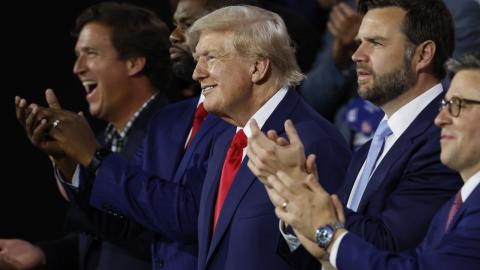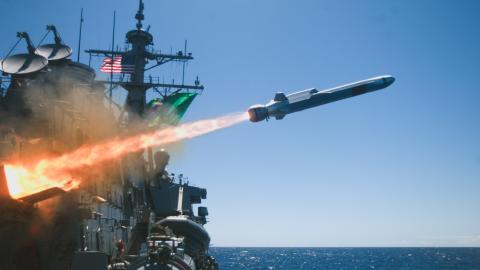To delve into where Taiwan and QUAD will converge in the future, we need to ask ourselves a few simple questions: What is the meaning of QUAD in today’s Indo-Pacific and why is Taiwan important in this emerging context of the Indo-Pacific?
The QUAD is a security arrangement between Japan, the US, India, and Australia that started in 2007. An important feature of late Shinzo Abe’s speech in 2007 was that he introduced both the concepts of the Indo-Pacific and the QUAD at the same time. The Indo-Pacific designation allowed Abe to include both the Pacific and the Indian Oceans in one concept, replacing the concept of “Asia-Pacific,” which did not include the Indian Ocean region.
Because of rapid economic development, both the Pacific and Indian Ocean regions are increasingly emerging as influential regions in world politics. The International Institute for Strategic Studies in the UK pointed out that nominal Asian defense spending (excluding Australia and New Zealand) overtook that of NATO Europe in 2012. Therefore, to explain current trends in world politics, Abe saw a need for new concepts that tied in all ascendant regions, including both the Pacific and the Indian Ocean regions.
This rising Indo-Pacific region has been under threat. Abe believed that it should not be a China-dominated region. He explained this idea in his article, “Asia’s Democratic Security Diamond,” which was published in Europe just before he was sworn in as Prime Minister for a second time in 2012. Therefore, the Indo-Pacific is a geographic concept that includes all the countries surrounding China. The QUAD includes all the great powers except China.
In addition, Abe wanted to emphasize the importance of India and its integration into the QUAD with the concept of the Indo-Pacific (instead of the Asia-Pacific, which did not include India). Both Japan and Australia are longtime US allies with established modes of cooperation. India was the newcomer. To cooperate with India, Japan needed the QUAD.Abe introduced these ideas with a view to maintaining order in the rising Indo-Pacific. After Abe’s speech, many other countries created their own definitions of the “Indo-Pacific.” But because the US’ Indo-Pacific strategy was created based on Abe’s original concept, his strategic formulation has survived. Now let’s come to another question: What’s the meaning of Taiwan in the increasingly intensifying Indo-Pacific geopolitics?
Firstly, Taiwan is located in front of the Coastal cities of China, which are of core interest to China’s security. Missile launches from Taiwan can reach these vital cities. When the QUAD thinks about a counter-China strategy, Taiwan is the weak point of China and a strong card for the QUAD.
Secondly, QUAD cannot escape from China if China invades Taiwan. It will automatically escalate to a China vs US-Japan war. For example, when China invades Taiwan, the US will defend Taiwan. If Japan does not join the war despite the US intervening, the US will not think of Japan as an ally of the US. Additionally, US fighter jets will defend Taiwan from the air bases in Japan. If China does not attack these air bases in Japan, the US fighter jets will get safe airbases and will be at serious risk against China’s operation. If China really wants to win the war, China will need to attack these airbases in Japan. This means that Japan cannot escape from China’s military operations against Taiwan. And indeed, if China invades Taiwan, many countries will send troops and air transport planes to Japan (and the Philippines) to support Taiwan or evacuate their nationals in Taiwan (and China). This means that Japan cannot prevent its military base from supporting Taiwan anyway.
Thirdly, for India, Taiwan is a key. If China focuses on Taiwan, China’s military forces concentrate on Taiwan and cannot relocate the other side of China to invade India. That is why India’s Taiwan policy has changed one by one. Originally, China viewed India as a supporter of its One-China Policy. Just after the Chinese Communist Party integrated the continental side of present-day China, India established formal diplomatic relations with Beijing and cut ties with Taipei. However, that attitude has changed. In 1995, India restarted relations with Taiwan, and 2008 was the last year that India’s government documents clearly mentioned the One China Policy.
This change has accelerated under Prime Minister Narendra Modi. For example, in 2014, then External Affairs Minister Sushma Swaraj said, “When they raised with us the issue of Tibet and Taiwan, we want they should understand and appreciate our sensitivities regarding Arunachal Pradesh.” Without China accepting India’s claim, India will not accept China’s claim, she said.
After tensions along the India-China border were raised in the spring of 2020, India went one step further. In May 2020, two Indian members of Parliament and the de facto Indian “ambassador” to Taiwan joined the online ceremony for the second-term inauguration of Taiwanese President Tsai Ing-wen. This was a major change, because the Modi government did not send members of Parliament to Tsai’s first inauguration in 2016 after initially considering it. Chinese troops killed at least 20 Indian soldiers and injured 76 on the India-China border in June 2020, one month after the second ceremony.
India’s move toward exporting arms to Taiwan also indicates that its attitude is changing. In 2018, along with the US and Japan, India planned to join Taiwan’s domestic submarine development program. In the future, India, not only the US, and Japan, will promote greater cooperation with Taiwan. That will raise Taiwan’s international status, making it more difficult for China to invade.
Based on the aforementioned points, although India will not join military operations to defend Taiwan, it is vital to create the international conditions that would make a Chinese invasion more difficult. That is why the US, Australia and Japan should cooperate with India to support Taiwan.




















